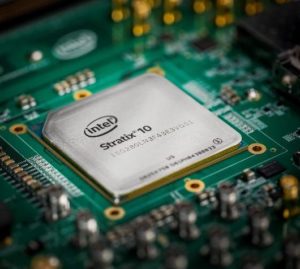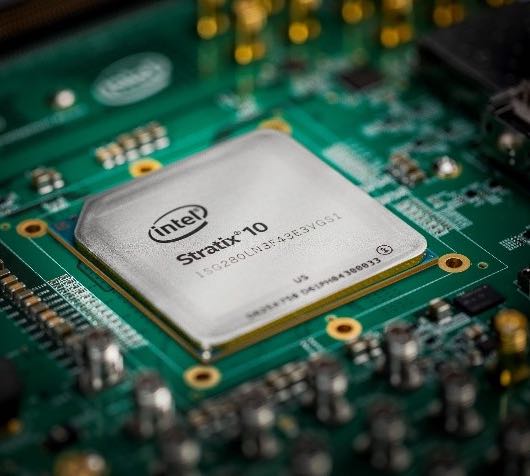
Stratix 10 FPGAs and SoC FPGAs leverage Intel’s 14nm process
Sponsored Post
In the past few years, accelerators that speed up certain classes of problems have made headway from the lab to production environments. Field Programmable Gate Arrays (FPGAs) are an exciting technology that allows hardware designers to create new digital circuits through a programming environment. Compared to hardware that is designed once or software which must adhere to the hardware architecture, an FPGA allows developers to draw a circuit to solve a specific problem.
FPGAs are programmed to simulate a hardware circuit. The design of this circuit only lasts while power is supplied to the FPGA, once it is powered off, the design is gone. Downloading the design from an application or at system boot time basically turns on the FPGA to be used by an application. FPGAs contain a highly parallel architecture which enables very high performance for certain applications with very low latencies. Intel is leading the way to giving a wider range of developers the tools necessary to create innovative uses of FPGAs.
[clickToTweet tweet=”Intel FPGAs can help to speed up a wide range of applications. Check out Intel FPGAs” quote=”FPGAs are an essential tool in a variety of domains.”]FPGAs are becoming an essential tool in diverse fields such as autonomous driving, cloud computing and accelerated networking. In all of these domains, very large amounts of data are produced, which is where FPGAs can contribute significantly. Automated vehicles are dealing with about 1 Gigabyte of data per second and the system must deal with all of this data in almost real-time. Only fractions of a second are available for the system to detect and react to an incident. New wireless network standards are demanding tremendous performance just as it is estimated that the data handled on wireless networks will exceed wired data in the not too distant future. As many industries move towards cloud computing, FPGAs located in large datacenters will be able to handle the enormous processing power that is need to address large scale requirements.
Previously programming an FPGA required knowledge of the underlying hardware systems using programming languages that were familiar to hardware designers. In order to broaden the appeal to software designers, new programming environments need to be developed that software developer are more familiar with.
Software stacks are being developed by Intel that allow a developer to create an application that is implemented in the FPGA. The lower level expertise is used in creating the libraries that are used and has the architectural expertise embedded in the libraries. By allowing different types of developers access to the software stack at different levels, a wider range of applications can be created that are run on FPGAs.
Intel is creating a number of technologies that will enable more development of applications that run on FPGAs. From the actual hardware itself to programming tools and libraries, and complete stack is being made available for a wide range of developers. The tools that Intel is creating allow for more optimized and simplified hardware interfaces and software Application Programming Interfaces (APIs). Developers can create application that are highly tuned to the problem at hand, and expect very high performance.
Intel helped create the Open Programmable Acceleration Engine (OPAE) which can handle many tasks, including all the details of the FPGA reconfiguration process. OPAE also contains drivers, libraries, and example programs that developer can quickly become productive with.
Intel is leading the FPGA world with highly programmable FPGA solutions. Moore’s Law has given FPGA designers a lot to work with, and the designers, in turn, have used those transistors to add features with software programmability in mind. Intel has released a framework to help system owners, application developers, and FPGA programmers interact in a standard way—a real advantage when using Intel FPGAs through a common developer interface, tools, and IP that make it easier to leverage FPGAs and reuse code.




